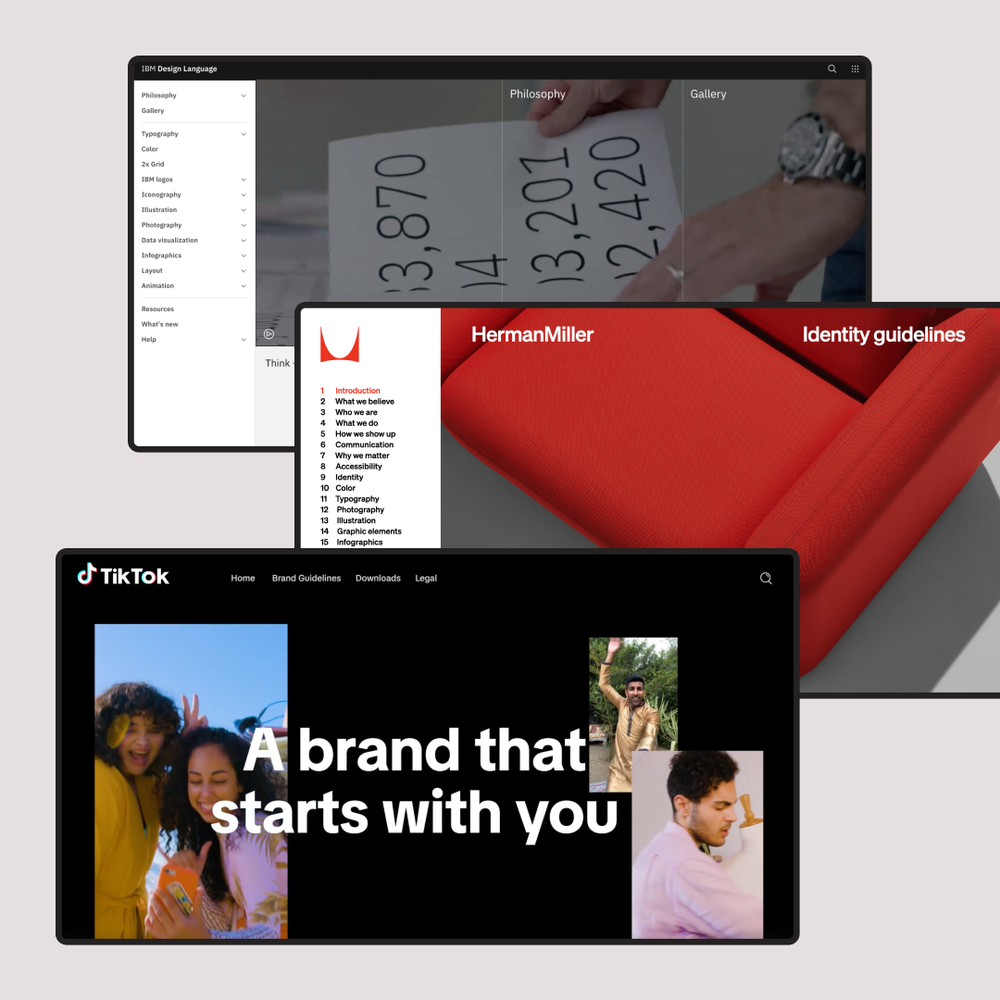A corporate branding strategy is a long-term plan that defines how a company builds, expresses, and manages its brand identity to shape perception and drive business performance. But even the strongest brands can’t rely on recognition alone. Think about how legacy giants like IBM, GE, or Microsoft have evolved; not by changing their logos, but by redefining what their brands stand for in the face of digital transformation and shifting customer expectations.
For many enterprise organizations, the challenge lies in fragmentation. Teams are disconnected, execution is inconsistent, and they can’t figure out how to measure brand performance effectively. Leading organizations now treat brand strategy as a core business capability, not just a marketing exercise.
This guide breaks down what a corporate branding strategy is, why it matters, and how to build one that delivers measurable business impact.

What is a corporate branding strategy?
A corporate branding strategy is the comprehensive framework that guides how organizations build, manage, and leverage brand equity across all touchpoints and stakeholder relationships.
While product branding focuses on offerings, and marketing campaigns use short-term tactics, a corporate branding strategy is a long-term, company-wide initiative that influences every product, message, and experience.
Corporate branding used to be more logo-centric. Now, customers judge brands on both their visuals and on their behaviors, values, and experiences. Every customer interaction, from a tweet to a help-desk call, communicates the brand as much as the logo does.
Why a corporate branding strategy matters for enterprise success
A corporate branding strategy creates a foundation that aligns the entire organization around a single identity and shared purpose. A strong strategy directly impacts enterprise growth, efficiency, and resilience.
When the brand is unified across the enterprise, it drives measurable benefits in areas such as:
- Competitive differentiation: A unified brand is more likely to have a trusted reputation that improves credibility and perceived value across all products, services, and business units. When potential customers, investors, and partners associate your brand with consistent quality, innovation, or purpose, it strengthens pricing power, supports premium positioning, and increases enterprise valuation.
- Operational efficiency: A strong corporate branding strategy standardizes brand decisions and centralizes tools and assets so teams don’t waste time reinventing materials, debating design choices, or fixing inconsistencies. A shared framework eliminates duplication, reduces off-brand work, and lowers both production and reputational costs across the enterprise.
- Stakeholder trust: Consistency keeps every interaction in line with your company’s values and commitments. This reliability builds confidence among investors, customers, and employees, helping protect market capitalization and reputation even in periods of uncertainty or crisis.
Essential components of a corporate branding strategy
There are four key elements that define comprehensive corporate brand management.
Brand architecture and hierarchy design
In a corporate branding context, companies use brand architecture and hierarchy to help customers and stakeholders understand the relationship between the parent company and its offerings. They allow the organization to leverage brand equity efficiently, to avoid brand confusion or dilution.
A clear structure also makes strategic decision-making easier. For instance, it can help a brand decide whether to launch a new product under the existing brand (to benefit from existing recognition) or create a new sub-brand (to target a different audience).
Most large organizations use one of these four structures:
- Branded House (e.g., Google → Google Maps, Google Drive, Google Ads)
- House of Brands (e.g., Procter & Gamble → Tide, Pampers, Gillette)
- Endorsed Brand (e.g., Marriott Bonvoy → Courtyard by Marriott, Residence Inn by Marriott)
- Hybrid (e.g., Microsoft → Microsoft 365, LinkedIn, Xbox)

A well-defined architecture lays the foundation for effective brand governance. The architecture helps you define rules for naming, design, and messaging consistency to keep every product and sub-brand aligned with the corporate identity.
Brand positioning and messaging strategy
A corporate brand’s positioning defines how it’s perceived in the market and what makes it distinct from competitors. When positioning is clear, it gives every audience a consistent reason to choose, trust, and invest in the brand.
Strong corporate positioning articulates the brand’s value proposition at a strategic level. It clarifies:
- What the organization stands for → its purpose and promise.
- The unique benefit it delivers → how it creates value differently than competitors.
- The role it plays in customers’ or partners’ success → why it matters.
For example, Adobe’s positioning centers on “creativity for all,” expressing its role in empowering people and organizations to design and communicate their ideas. That focus on creative empowerment shapes its messaging across audiences.
Messaging frameworks translate that positioning into consistent language across all touchpoints. These frameworks define the key messages, proof points, and tone that bring the corporate brand’s strategy to life in everyday communication.
Defining a unified brand voice and personality ensures that all teams express the brand in a way that feels cohesive and credible. Whether a CEO is addressing shareholders or a recruiter is writing a job post, your tone of voice should reflect the same underlying character and values.
Visual identity and design systems
A corporate brand’s visual identity translates strategy into a recognizable and cohesive look and feel. A comprehensive design system keeps visual elements, including logos, color palettes, typography, and imagery, consistent across all touchpoints (while still allowing flexibility for different regions, products, and platforms).
Strong design systems are supported by clear brand guidelines that explain how to apply brand standards correctly. These guidelines establish visual boundaries and creative direction, so every asset reflects the same core identity.
Modern design systems are digital-first, ensuring that interfaces, motion, and responsive layouts feel seamless across devices while integrating smoothly into offline experiences. When unified through a shared design framework, the visual identity becomes more than a style; it’s a scalable system that connects every brand interaction back to the corporate whole.

Brand governance and compliance frameworks
Brand governance frameworks empower your teams to apply your corporate branding, identity, and messaging consistently across every market, team, and channel. Effective governance systems establish transparent processes, accountability structures, and performance measures to protect your brand’s integrity as it scales. Common governance elements include:
- Defined ownership and decision rights to clarify who manages brand assets and approvals.
- Standardized workflows and tools that make compliance part of daily operations.
- Ongoing performance tracking through audits or brand health scorecards.
Strong governance is proactive, not restrictive. It empowers teams to make on-brand decisions confidently through defined roles, approval workflows, and access to approved assets and templates. These systems help maintain quality and consistency without slowing creative or operational efficiency.
Compliance monitoring tools — such as automated audits, brand scorecards, or digital asset permissions — further ensure accuracy and alignment. They identify and address inconsistencies before they affect market perception or stakeholder trust. When governance and compliance are embedded in daily workflows, brand standards become second nature.
Corporate branding strategy by organization type
Different types of organizations use various approaches to build their corporate branding strategies. Here are four examples.
Multi-national enterprises and global brands
Multi-national enterprises have a unique challenge of maintaining brand consistency across diverse cultural, regulatory, and competitive environments while respecting local market requirements.
A balance of global and local brand strategy can balance your overall brand equity while enabling regional customization and cultural relevance.
Global enterprises rely on structured coordination systems, like centralized brand hubs or regional governance frameworks, to align global strategy with local execution. Local teams can adapt messaging and creative assets to regional markets while maintaining overall brand coherence and operational efficiency.
Holding companies and brand portfolios
Holding companies rely on portfolio brand management approaches that balance autonomy and alignment, allowing each brand to perform independently while benefiting from shared resources, expertise, and governance frameworks.
A strong corporate branding strategy adds value to subsidiary brands by providing strategic clarity, financial stability, and operational infrastructure without diluting their distinct market identities.
When managing acquisitions, the goal is to integrate systems, processes, and culture in ways that enhance overall portfolio value while preserving the acquired brand’s equity and customer trust.
B2B enterprises and professional services
For B2B enterprises and professional services, brand success depends less on mass visibility and more on credibility, expertise, and trusted relationships. A corporate branding strategy in this context emphasizes reputation management and thought leadership by using insights, case studies, and industry commentary to demonstrate authority and influence.
B2B and professional services brands align brand communications with business development goals to differentiate themselves in competitive, expertise-driven markets. They use strategies that tailor messaging to diverse stakeholders — clients, partners, regulators, and prospective talent — to ensure the brand resonates across complex, relationship-based decision processes.
Technology and innovation companies
Tech companies face the challenge of maintaining brand consistency amid rapid growth, global expansion, and frequent product launches and updates. Their corporate branding strategies must convey innovation and agility while reinforcing reliability so they can earn trust with enterprise buyers, investors, and partners.
To achieve this balance, leading tech brands position themselves as both visionary and dependable, grounding bold innovation in proven expertise and customer success. Agile brand management frameworks enable these organizations to evolve quickly without losing strategic cohesion.
How AI and digital asset management transform corporate brand management
Together, AI and DAM turn brand strategy into operational capability. When they work together, they enable organizations to align insights, execution, and governance across every brand touchpoint.
Data-driven brand strategy and performance improvement
AI-powered analytics turn brand strategy from guesswork into data-driven decisions. By reading millions of data points, from customer feedback to market trends, AI reveals how people really feel about your brand, where it stands against competitors, and where new opportunities are emerging.
Predictive models can even forecast how a campaign, product launch, or brand refresh will shape perception and performance before it happens. For example, an AI model might detect that sentiment around a company’s sustainability messaging is declining in key markets, so you can make changes before a campaign goes live.
When this intelligence connects to your digital asset management (DAM) system, it gives you insights about how your strategy plays out in real time and gives you the data you need to fine-tune every move. With these insights, your executives also get real-time visibility into brand health, campaign impact, and ROI across every market and channel.
Intelligent brand governance and compliance
AI takes brand governance from reactive policing to proactive protection. With AI-powered compliance monitoring and DAM-based controls, brands can automatically spot inconsistencies, flag off-brand content, and ensure only approved assets make it into the world. Role-based access, version control, and automated approvals create a built-in safety net to keep every file, visual, and message on-brand.
Intelligent assistants, like Frontify’s Brand Assistant, bring this governance to life by surfacing the right rules and assets in the same tool where teams work. Over time, AI learns from patterns and user behavior to strengthen compliance, improve content quality, and make brand alignment effortless at scale.
Scalable execution and strategic enablement
A great strategy only works if your teams can bring it to life. DAM platforms make that possible by connecting brand guidelines directly to assets, templates, and creative tools, turning strategy into action. AI helps you scale by automating tagging, content review, and recommendations, so you can always find the right, compliant materials without the manual lift.
Integrated with marketing, design, and collaboration tools, AI-enabled DAM systems embed brand management into daily workflows. The result: faster execution, consistent quality, and a brand that moves as confidently as the business behind it.
How to implement a corporate branding strategy
To implement your new corporate branding strategy, break it up into three stages, with each stage having its own action steps.
1. Start strategic planning and get stakeholder buy-in
- Conduct research: Run internal and external audits to understand how your brand is currently perceived, used, and governed. Gather insights from employees, customers, and partners to identify alignment gaps and brand performance challenges. Benchmark competitors and industry leaders to define where your brand needs to evolve and what governance structures will best support it.
- Secure leadership commitment: Write up a business case that links brand strategy to organizational goals, financial impact, and risk reduction. Present precise data and examples that show how consistent branding drives value.
- Establish governance structures: Define clear roles and responsibilities for brand decision-making across teams and regions. Create a governance framework that outlines approval workflows, usage rules, and accountability measures. Document all of these and keep the resource in your DAM so everyone has access to it.
2. Plan a rollout that prioritizes adoption
- Phased rollouts: Start with a pilot rollout that focuses on your core and highly impacted users. Have them test the strategy’s messaging, tools, and workflows. Gather feedback, refine assets and processes, then expand in waves to additional departments or regions. Build milestones and checkpoints into each phase to track adoption of the strategy and address roadblocks.
- Training: Create and tailor role-based training programs to how each team interacts with your brand. Focus on hands-on learning that shows employees where to find assets, how to apply guidelines, and how to use new tools or platforms. Schedule refresher sessions and create easily accessible tutorials or help hubs to keep training ongoing as the brand evolves.
- Technology adoption: Choose a centralized brand management platform, like a digital asset management solution, that unites guidelines, assets, and templates in one place. A DAM makes it easier for your teams to stick to your corporate branding strategy. Integrate it with existing tools, like your creative suites, CMS, and collaboration platforms, to embed brand access into daily workflows.
3. Measure performance and iterate as needed
- Measure impact: Define key performance indicators (KPIs) that track both internal adoption (like platform engagement, asset usage, and compliance rates) and external outcomes (like brand awareness, sentiment, and market perception).
- Use data for continuous improvement: Set up dashboards or reporting tools to collect and visualize this data over time. Compare results against your baseline metrics to identify what’s working, where gaps remain, and which areas need refinement.
- Report results to leadership: Create a recurring reporting cadence (e.g., monthly or quarterly) to keep leadership informed on progress and impact. Tie every data point back to business outcomes like efficiency gains, cost savings, or brand value to sustain executive alignment and support.
The biggest risks in executing a brand strategy
Even large enterprises with sophisticated brand strategies often fall into predictable traps that undermine consistency, adoption, and ROI. Here are some risks to avoid:
- Treating branding as a one-time campaign. Branding requires continuous governance and iteration. One-off rebrands or campaigns quickly lose alignment as markets, teams, and portfolios evolve.
- Over-focusing on visual identity. Logos and design systems only deliver value when they’re tied to governance frameworks and embedded into workflows.
- Neglecting employee engagement. Employees are the frontline of your brand experience. Without training and alignment, your corporate branding strategy breaks down in the execution phase, which creates inconsistent messaging.
- Relying on fragmented tools. Disconnected platforms create inefficiencies and compliance risks, especially for enterprises managing multiple markets, subsidiaries, and external agencies.
- Failing to measure performance. Without KPIs like adoption and compliance rates and asset reuse, leaders can’t prove ROI or optimize strategy, making branding vulnerable to budget cuts.
Why Frontify is the platform for effective corporate branding strategies
Frontify brings every element of corporate brand strategy into one connected platform. Through Frontuify, you can unite strategy, guidelines, digital asset management, and templates in a single source of truth. Everyone — from designers and marketers to partners and leadership — works from the same playbook, so every expression of the brand is consistent and aligns with the strategy.
Fragmented tech stacks, by contrast, create friction and risk. Assets live in multiple systems, guidelines go unseen, and teams waste time searching, recreating, or approving materials that should already exist. The result is slower execution, higher costs, and inconsistent brand experiences that weaken trust and impact.
Frontify is built for enterprise governance from the ground up. Advanced permission structures let you control access by role, region, or business unit. Built-in audit trails record every change, so compliance and brand accountability are automatic. And AI-powered governance tools, like Brand Assistant, help users stay on-brand in real time by delivering contextual guidance pulled directly from your own brand documentation.

